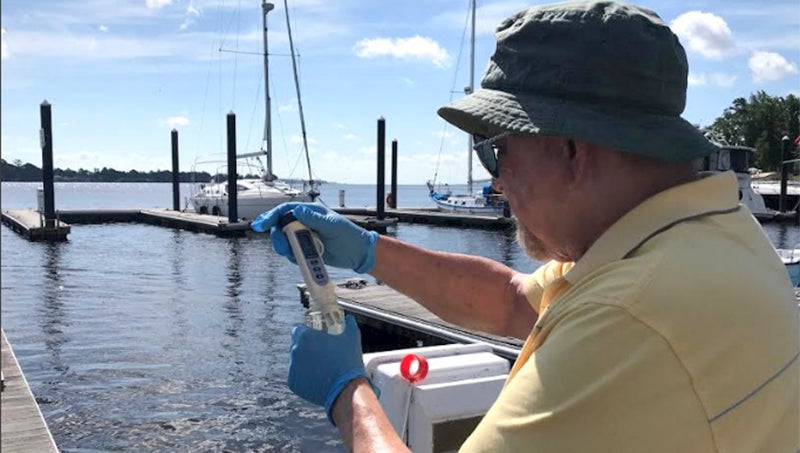Sound Rivers maps contaminated water sites
Published 7:32 pm Friday, July 26, 2019

- BACTERIA TESTING: Bill Sholl takes a water sample from Cypress Landing for testing for Sound Rivers’ Swim Guide program. (April Turner)
By SABRINA BERNDT
Washington Daily News
Sound Rivers, a nonprofit focusing on the health of the Neuse and Tar-Pamlico river basins, has been busy monitoring bacteria in local watersheds since Memorial Day.
The Sound River’s Swim Guide team samples water sites for E. coli and enterococci, which can both cause health issues, such as gastrointestinal problems. The sample results are then published online every week to assist the public in making informed decisions before spending a day in the water.
“Swim Guide is a weekly water quality monitoring program that runs Memorial Day weekend to Labor Day weekend,” Swim Guide intern April Turner said. “We basically test for fecal bacteria at the sites, which are primarily recreational sites.”
According to Turner, high levels of fecal bacteria can come from multiple sources, such as septic tank leaks, animal waste or rain. Swimming in these contaminated areas can lead to multiple health risks, including gastrointestinal issues, skin infection, nausea, diarrhea and more.
The Sound Rivers team of interns and volunteers visit select watershed sites regularly and take two samples, one sterile and one temperature-controlled sample, at each site. Once the samples are taken to the office, the team places a specific reagent in each sample to test for E. coli in freshwater samples and enterococci in salt water.
When the reagent is mixed with the 100-milliliter sample and cooked for 24 hours, it is observed under a blacklight to get the number of bacteria. For E. coli, a number exceeding the amount of 235 MPN, or most probable number, in a standard sample is considered unsafe. For enterococci, the limit is 104 MPN.
“If people are going out and interacting with water that they’re not aware that it has high levels of bacteria, they can get infections and all kinds of things from the bacteria in the water,” Turner said.
According to Turner, the program is a free, reliable way for the public to educate themselves about the risks involved with swimming in contaminated water — something most people do not consider before jumping in.
“When I get asked about why I’m doing this internship, I kind of bring light to (people not knowing about the risks),” Turner said. “You really don’t think about it, but there’s more to just what we’re eating and what we’re touching out in nature also.”
The public can find Swim Guide multiple ways, including the website (soundrivers.org/swimguide/), Sound Rivers’ Facebook page, the Swim Guide app or receiving weekly texts. Swim Guide also welcomes volunteers, donations or sponsors.





